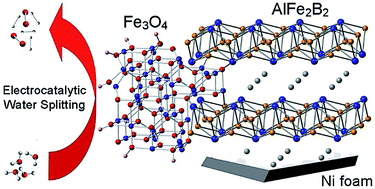Efficient, Earth-abundant Electrocatalytic Material for Water Oxidation
- US and European Patents Pending
AlFe2B2 exhibits excellent electrocatalytic performance in oxygen-evolution reactions, and is inexpensive, facilely synthesized, and comprised of earth-abundant elements.
Key Benefits
- AlFe2B2 serves as an excellent oxygen-evolution reaction (OER) pre-catalyst and has long-term stability under alkaline conditions.
- This material outperforms well-known platinum group metal catalysts, including IrO2 and RuO2, as well as Co- and Ni- containing noble-metal-free catalysts
- The material is made of readily available and inexpensive materials and is synthesized simply by arc-melting followed by ball-milling.
Technical Summary
Fast depletion of fossil fuels drives extensive research efforts aimed at the development of renewable energy sources, including water electrolysis to produce fuel cells. The state-of-the-art electrocatalysts are Pt, IrO2, and RuO2, which are expensive and limited in their reserves. AlFe2B2 is a promising alternative due to its low-cost and lack of noble-metal elements. AlFe2B2 acts as a scaffold for the in situ formation of catalytically active Fe3O4 nanoclusters. The material is exceptionally efficient and exhibits substantially lower overpotentials at all current densities when compared to commonly used electrocatalysts. The material is also remarkably stable and an overpotential value of 240 mV was observed at a constant current density of 10 mA cm-2 for more than ten days. These outcomes establish AlFe2B2 as a highly active and inexpensive OER electrocatalyst with remarkable long-term stability.
Development Stage
AlFe2B2 has been thoroughly tested and evaluated in a laboratory setting and is currently undergoing further testing and refinement in industry-scale environments. Further research into improved variations are also ongoing.


